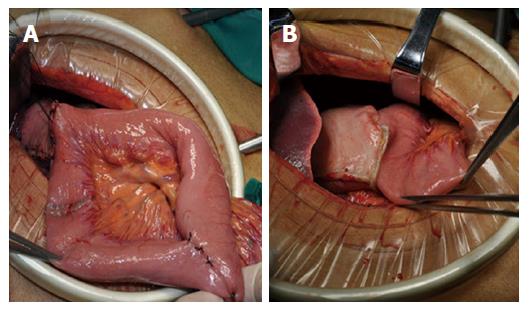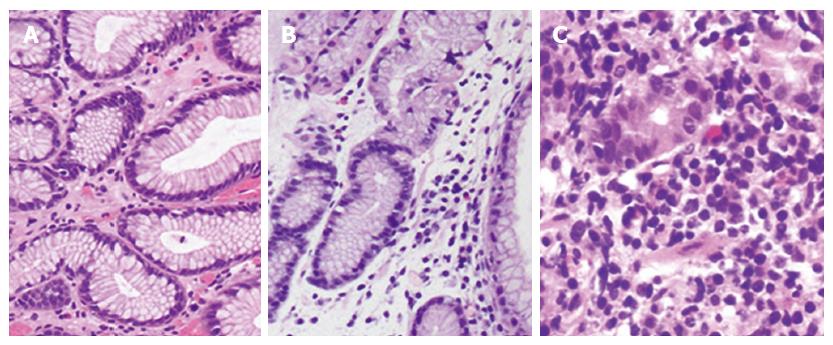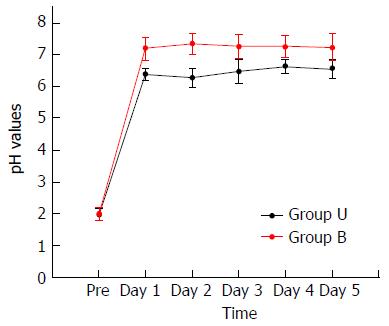Copyright
©The Author(s) 2017.
World J Gastroenterol. Sep 14, 2017; 23(34): 6350-6356
Published online Sep 14, 2017. doi: 10.3748/wjg.v23.i34.6350
Published online Sep 14, 2017. doi: 10.3748/wjg.v23.i34.6350
Figure 1 Two kinds of reconstruction after laparoscopy-assisted distal gastrectomy.
A: Uncut Roux-en-Y reconstruction; B: Billroth II reconstruction. All included patients underwent LADG with D2 lymphadenectomy, which was performed by the same surgical team. Then, two groups underwent different reconstructions as shown.
Figure 2 Bile reflux grades.
During the endoscopic examination, a modified biliary reflux classification in three grades was applied. A: grade 0, absence of bile (Figure 2A); B: grade 1, small amount of bile located in the bottom of residual stomach without overflow (Figure 2B); C: grade 2, bile spilled into the jejunum with tidal rhythm (Figure 2C).
Figure 3 Biopsy for gastritis.
Gastric tissue biopsies were taken to compare the degree of gastritis: A: grade 0 [hematoxylin and eosin (HE) staining, × 200], normal mucosa with small amount of lymphocytes and transparent microscopic field; B: grade 1 (HE, × 200), intermediate between grades 0 and 2 with a moderate amount of lymphocytes or other kinds of inflammatory cells; C: grade 2 (HE, × 400), acute inflammation with fully infiltrated tissue by lymphocytes or other kinds of inflammatory cells.
Figure 4 Perioperative potential of hydrogen (pH) in the stomach of the patients.
Change of potential of hydrogen (pH) in the remnant stomach was recorded at 8:00 am on the day before surgery as well as 1-5 d after surgery. During the postoperative period, all stomach pH values of group U patients were below 7.00. Conversely, all stomach pH values of group B patients were higher than 7.00.
- Citation: Yang D, He L, Tong WH, Jia ZF, Su TR, Wang Q. Randomized controlled trial of uncut Roux-en-Y vs Billroth II reconstruction after distal gastrectomy for gastric cancer: Which technique is better for avoiding biliary reflux and gastritis? World J Gastroenterol 2017; 23(34): 6350-6356
- URL: https://www.wjgnet.com/1007-9327/full/v23/i34/6350.htm
- DOI: https://dx.doi.org/10.3748/wjg.v23.i34.6350












